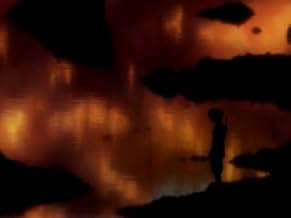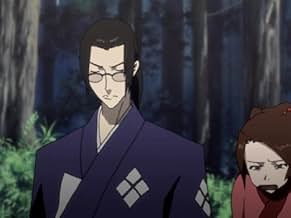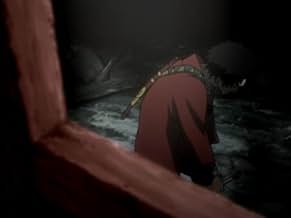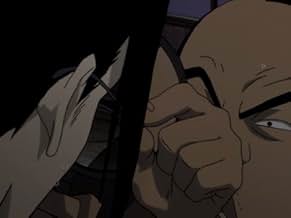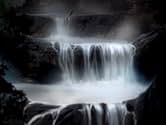Fuu, une serveuse employée dans une maison de thé, sauve deux maîtres épéistes, Mugen et Jin, de leur exécution pour qu'ils l'aide à trouver le « samurai qui sent le tournesol ».Fuu, une serveuse employée dans une maison de thé, sauve deux maîtres épéistes, Mugen et Jin, de leur exécution pour qu'ils l'aide à trouver le « samurai qui sent le tournesol ».Fuu, une serveuse employée dans une maison de thé, sauve deux maîtres épéistes, Mugen et Jin, de leur exécution pour qu'ils l'aide à trouver le « samurai qui sent le tournesol ».
Parcourir les épisodes
Résumé
Reviewers say 'Samurai Champloo' is acclaimed for merging Edo-period Japan with modern hip-hop, featuring a standout soundtrack by artists like Nujabes. Characters Mugen, Jin, and Fuu offer distinct personalities and fighting styles, enhancing the show's eclectic tone. The animation is lauded for dynamic fight scenes and vibrant art. Despite episodic structure and lack of a central plot, the series is praised for engaging character dynamics, humor, and its unique blend of historical and modern elements.
Avis à la une
Mugen is a fairly dim, self-taught swordsman who doesn't know how to hold back, Jin is the perfect samurai: cold, calculating, every move flawless. They could be no more different, and in fact one would gladly kill the other with the chance, but they are both reluctantly recruited by the ditsy teahouse waitress Fuu after she saves them from execution.
Samurai champloo is the story of Mugen, Jin and Fuu, as they journey across Japan trying to find "The samurai who smells of sunflowers." All the way they meet all sorts of people, get into trouble, and try to make money. As the show progresses, the mysteries of the characters pasts are slowly revealed.
Samurai champloo is an excellent series from the people who made Cowboy Bebop, the animated sequence in Kill Bill, and a few sequences in the Animatrix. The music is good, offering a wide variety of genres, the animation is excellent, and the dialog is kept to a bare minimum. Oh, and the comedy is great, too.
If you liked Cowboy Bebop, you will probably like Samurai Champloo. One's set in the future and has a lot of jazz music, the other's set long ago in Japan and has a lot of rap in the scene transitions. But the character types in both are pretty much the same, and in both the characters must come to terms with themselves. I recommend it to fans of this genre of anime.
Samurai champloo is the story of Mugen, Jin and Fuu, as they journey across Japan trying to find "The samurai who smells of sunflowers." All the way they meet all sorts of people, get into trouble, and try to make money. As the show progresses, the mysteries of the characters pasts are slowly revealed.
Samurai champloo is an excellent series from the people who made Cowboy Bebop, the animated sequence in Kill Bill, and a few sequences in the Animatrix. The music is good, offering a wide variety of genres, the animation is excellent, and the dialog is kept to a bare minimum. Oh, and the comedy is great, too.
If you liked Cowboy Bebop, you will probably like Samurai Champloo. One's set in the future and has a lot of jazz music, the other's set long ago in Japan and has a lot of rap in the scene transitions. But the character types in both are pretty much the same, and in both the characters must come to terms with themselves. I recommend it to fans of this genre of anime.
This anime tells the obscure story of 2 samurai bound to a girl on a quest for a samurai who smells of sunflowers. She constantly conceals her motiviation for doing so.
The comedy element in this anime is excellent. A deliberate pairing comparable to Spike and Jet in cowboy beebop exists with one vagabond samurai and one honorable samurai. Both samurai have a completely contrasting fighting style which makes for great action scenes and simultaneous plots (where one is fighting on one side of a city and another is fighting on the other).
Similar plot style to cowboy beebop, via meetings with people from their past, both characters pasts are slowly revealed with a clear direction toward finding the samurai who smells of sunflowers. There's a constant struggle to find the basic necessities like food and a real feel to the plot as opposed to anime where you're left wondering if they've gone six months without a shower or a bath.
As i said, best anime i've ever scene, hilarious :D
The comedy element in this anime is excellent. A deliberate pairing comparable to Spike and Jet in cowboy beebop exists with one vagabond samurai and one honorable samurai. Both samurai have a completely contrasting fighting style which makes for great action scenes and simultaneous plots (where one is fighting on one side of a city and another is fighting on the other).
Similar plot style to cowboy beebop, via meetings with people from their past, both characters pasts are slowly revealed with a clear direction toward finding the samurai who smells of sunflowers. There's a constant struggle to find the basic necessities like food and a real feel to the plot as opposed to anime where you're left wondering if they've gone six months without a shower or a bath.
As i said, best anime i've ever scene, hilarious :D
With 1998's "Cowboy Bebop", one of the most acclaimed anime TV series ever (go read the comments index for it here on IMDb if you don't believe me!), Shinichiro Watanabe became a creative force to watch out for. The innovative energy, drama and beauty of "Bebop" are carried forward in his second original series, "Samurai Champloo". Fans have been quick to look for similarities between "Bebop" and "Champloo" (even the titles have clear parallels), and it's true there are some: the assembly-of-rootless-loners cast of characters, the dramatic and cinematic visual style, and especially the importance and integration of music into the storytelling mix--in SC's case, everything from hip-hop beatboxing to Ainu and Okinawan folksong. But "Champloo"'s differences from "Bebop" are much more interesting than its likenesses. "Bebop" is drenched in melancholy and regret, dreams of the lost past and the future that couldn't be. "Champloo" is all about facing the future, the wave of change, the onrush of history that can't be stopped, and how three kids from widely diverse backgrounds--not even friends when they set out-- find themselves right on the crest of that wave. We're in Edo Period Japan; since 1638 the Tokugawa Shogunate has banned contact with all countries except China and Japan, a ban that lasted two centuries. The outside world can't be kept outside forever. Even the long-respected samurai class is losing its power, and there's restlessness in the land plus accompanying pressure from the Shogunate on all sides. Through this uneasy landscape (rendered in lushly beautiful watercolors that might remind you of Miyazaki) wander our cast of characters: outlaw ronin Jin, a gifted swordsman, stoic, disciplined and heartbreakingly gorgeous, devoted to the bushido code but exiled for killing his sensei; Okinawan wild-boy Mugen, orphan, former pirate and brilliant innovator, whose fighting style mixes everything from Brazilian capoeira to break-dancing, and whose feral-child innocence faces the toughest tests in the series; and teahouse waitress Fuu, spunky, compassionate and packing a lot of secrets, who rescues the two swordsmen from the executioner's block and enlists them on her quest to avenge her mother's death. On their long walk from Edo to Nagasaki they'll see a lot, face a lot of trials, starve, quarrel, save each other's lives, break up, re-bond, and become inseparable. Except that Jin and Mugen still swear they'll fight to the death one day, and no one (not even Fuu) is saying anything about the Sunflower Samurai, the object of Fuu's quest.
Have I made this sound like a straight historical drama? I ought to mention that it can be hysterically funny as well as vividly bloody, contains knockout fight scenes and anachronisms by the carload (the aforementioned break dancing and beatboxing, Jin's Armani glasses, the appearance of landmarks not built till the 1900s...), has made me cry more times than any anime since "Bebop", and has sharp things to say about the heavy hand of authority and tradition on groups as diverse as gay men, married women, foreigners, aboriginal natives and illegal aliens. It's unfailingly beautiful to look at (well, 95% unfailingly) and listen to, delectably well-written, and simply brilliant. When it gets to America, go find it.
Have I made this sound like a straight historical drama? I ought to mention that it can be hysterically funny as well as vividly bloody, contains knockout fight scenes and anachronisms by the carload (the aforementioned break dancing and beatboxing, Jin's Armani glasses, the appearance of landmarks not built till the 1900s...), has made me cry more times than any anime since "Bebop", and has sharp things to say about the heavy hand of authority and tradition on groups as diverse as gay men, married women, foreigners, aboriginal natives and illegal aliens. It's unfailingly beautiful to look at (well, 95% unfailingly) and listen to, delectably well-written, and simply brilliant. When it gets to America, go find it.
Samurai Champloo is directed by Shinichiro Watanabe and its sensational! This story is about kick ass warriors Mugen and Jin and a funny female Fuu on a journey to the find the samurai "who smells of sunflowers" the catch is Mugen and Jin don't really like each other very much but made a deal with Fuu that they would not fight each other till they find the samurai "who smells of sunflowers" This is what sets up the show to be very entertaining the show is often hilarious and than thrilling with kick ass sword fights etc. I'm not a huge hip-hop fan but damn it works its outstanding for this show the music is awesome...
Overall this is a must own DVD go buy it right now it is worth every cent I can't wait to get this whole set! 10/10
Overall this is a must own DVD go buy it right now it is worth every cent I can't wait to get this whole set! 10/10
Samurai Champloo is the long-awaited next project from Cowboy Bebop director Shinichiro Watanabe. His two short films in the Animatrix compilation (Kid's Story and Detective Story) give American audiences a sneak peek at the phenomenal art style of this series, but they barely hint at the jaw-dropping action and unorthodox blend of history and music contained therein.
The similarities with Bebop end at the fact that the series has three protagonists: the vagrant swordsman Mugen, the rogue samurai Jin, and the tea-shop waitress Fuu. This unlikely and volatile trio begin a road journey through post-shogunate Japan (ca. 1780), brought together by circumstances best seen to be believed.
"Champloo" means mixed-up or stir-fry, and that's what this series is: a stylish blend of old school values and situations, meshed with more modern sensibilities, fighting styles, and visual design. Over the lush, dynamic art, a soundtrack of some of the best hip-hop from modern Japan plays. Though it's a noticeable device in the first few episodes, it doesn't take long before the music feels like second nature despite the anachronism.
Champloo is many things: a mature drama, an action series, an uproariously funny comedy and a visual feast. Watanabe-san demonstrates here that the success of Cowboy Bebop was uniquely his, and no fluke - fans of that series will not be disappointed, despite how radically different the two story lines are from one another.
As the title card of the first episode of Samurai Champloo says, "Just shut up and watch."
The similarities with Bebop end at the fact that the series has three protagonists: the vagrant swordsman Mugen, the rogue samurai Jin, and the tea-shop waitress Fuu. This unlikely and volatile trio begin a road journey through post-shogunate Japan (ca. 1780), brought together by circumstances best seen to be believed.
"Champloo" means mixed-up or stir-fry, and that's what this series is: a stylish blend of old school values and situations, meshed with more modern sensibilities, fighting styles, and visual design. Over the lush, dynamic art, a soundtrack of some of the best hip-hop from modern Japan plays. Though it's a noticeable device in the first few episodes, it doesn't take long before the music feels like second nature despite the anachronism.
Champloo is many things: a mature drama, an action series, an uproariously funny comedy and a visual feast. Watanabe-san demonstrates here that the success of Cowboy Bebop was uniquely his, and no fluke - fans of that series will not be disappointed, despite how radically different the two story lines are from one another.
As the title card of the first episode of Samurai Champloo says, "Just shut up and watch."
IMDb's Top 50 Anime Series
IMDb's Top 50 Anime Series
See which anime series our fans recommend the most. Titles with more than 10,000 votes are featured in our ultimate anime watchlist.
Le saviez-vous
- AnecdotesThe series was only allowed to be aired past 12:00 am in Japan for the network deemed it too graphic for prime time television.
- Versions alternativesThe episodes aired on Adult Swim are edited for language and other content.
- ConnexionsFeatured in Troldspejlet: Épisode #33.3 (2005)
Meilleurs choix
Connectez-vous pour évaluer et suivre la liste de favoris afin de recevoir des recommandations personnalisées
- How many seasons does Samurai Champloo have?Alimenté par Alexa
Détails
Contribuer à cette page
Suggérer une modification ou ajouter du contenu manquant








